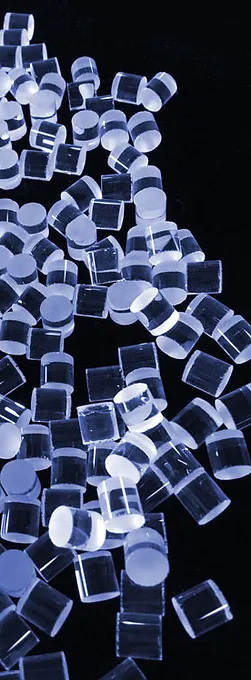Quartz Properties
Quartz provides a high purity level of SiO2 as well as desirable mechanical, electrical, thermal, chemical and optical properties that make it ideal for a variety of demanding applications across a number of areas, including general industrial, scientific/lab, lighting and heating, controls and sensors, medical devices, aerospace and more.
Chemical Composition
Silica glass is described by the generic term vitreous silica, with producers referring to it as either fused quartz or as fused silica. Initially, the two terms were used to distinguish between transparent and opaque grades. Fused quartz products were those produced from quartz crystal into transparent ware and fused silica was used to identify products made from sand into opaque ware.
With advances in raw material beneficiation, transparent fusions could be created from both sand and crystal. If naturally occurring crystalline silica (sand or rock) is melted, the material was then called fused quartz. If the silicon dioxide is synthetically derived, then the material was referred to as synthetic fused silica.
The performance of most fused quartz products is tied to the purity of the material. It is inert to most of chemical components, which is why it is widely used in the chemical industry and test laboratories.
Alkalis agents attack quartz glass, causing and accelerating the devitrification process. Hydrofluoridic and phosphoric acid are the only compounds that can etch the material, even at a low temperature.
Thermal Properties
Fused quartz glass delivers superior thermal stability over traditional glass, with a low thermal expansion coefficient (5.5 x 10-7 cm/cm°C) and the ability to not change color when heated to 1100°C and kept at this temperature for an hour. Heating fused quartz glass to the same temperature and then suddenly cooling it to 20°C demonstrates its excellent thermal shock resistance. Repeating this procedure three times, the piece of quartz glass does not break.
Fused quartz glass softens at about 1630°C, behaving like other glass types at this point. It does not have a specific fusion temperature. This state transformation lasts for a wide temperature range and is marked by the changing of viscosity with the variation of temperature.
Electrical Properties
Quartz acts as an exceptional electric insulating material. It offers a number of electrical properties, including:
electrical resistivity (350°): 7x107 ohm x cm
dielectric constant (20°C - 1MHz): 3,76
insulated strength (20°C - 1MHz): 5 x 107 V/m
dielectric absorbance constant: <4 x 10-4
dielectric ullage constant: <1 x 10-4
Mechanical Properties
The shape, impurity level or the presence of defects on the surface and the age of the material all influence the mechanical properties.
Viscosity and Devitrification
Because fused quartz has a very high viscosity, it flows slowly from the softening point until higher temperatures are reached, which enables the quartz to flow faster. The presence of impurities inside the material will have a large impact on viscosity.
The process of devitrification occurs after quartz has been exposed to very high temperatures for an extended period of time. The presence of impurities will make the devitrification process faster.
Optical Properties
Fused quartz has a much higher purity level than standard glass, which make its optical properties much better than standard glass. These optical properties depend on its transparency level and on the production method.


